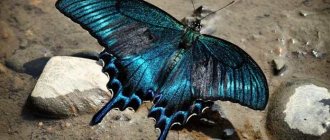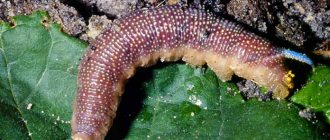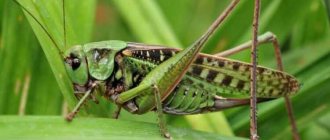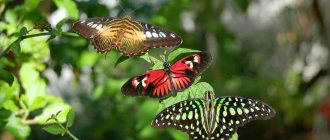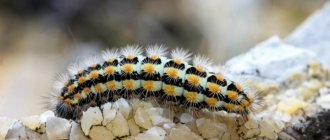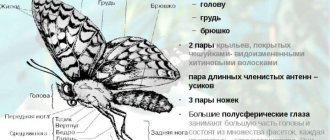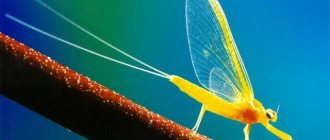Numerous orders of insects are conventionally divided into two groups. In representatives of the first group, the larvae emerging from the egg are similar to adult individuals and differ from them only in the absence of wings. These include cockroaches, grasshoppers, locusts, bedbugs, praying mantises, stick insects, etc. These are insects with incomplete transformation.
In the second group, the eggs hatch into worm-like larvae, completely different from their parents, which then turn into pupae, and only after that do adult winged insects emerge from the pupae. This is the development cycle of insects with complete transformation. These include mosquitoes, bees, wasps, flies, fleas, beetles, caddis flies, and butterflies.
Types of butterfly eggs
Butterfly eggs come in various shapes - round, flattened, oval, spindle-shaped, smooth or with a cellular surface, covered with spines or ribs. The color of the eggs is also different, most often whitish, light green or yellow, in addition, brownish, brownish-violet, reddish. The eggs of many species change color as they develop.
The manner in which eggs are laid may differ among different species of butterflies. Eggs can be laid one at a time or several at a time, or in large groups, up to several hundred in one clutch. Eggs can be laid on leaves, stems, flowers, fruits of plants, in cracks in tree bark, on soil, lichens, and on dry plant remains. After laying, females of some species cover their eggs with hairs from their abdomen.
How long does the egg stage of a butterfly last?
The egg stage in different species can last from several days in the warm season to many months if the eggs overwinter. As the egg develops, a caterpillar forms inside it, which then gnaws through the shell and comes out. In some species, the formed caterpillar overwinters inside the egg and emerges only in the spring. Caterpillars of many species eat the shell of their eggs immediately after emerging.
The body of caterpillars consists of thirteen segments, of which three are thoracic and ten are abdominal. The thoracic segments bear a pair of jointed legs; the abdominal segments usually have five pairs of false legs; some types of abdominal legs have two or three pairs, or they are underdeveloped. The appearance of caterpillars is very diverse and often differs even among closely related species.
Many are brightly and variegatedly colored, some have outgrowths in the form of horns, spikes, and bumps. The surface of the body is smooth with sparse scales or covered with dense hairs, warts, and spines. Body proportions also vary: some caterpillars are short and thick, others are thin and long.
Transformation of a caterpillar into a butterfly - the pupa stage
Pupation is the most vulnerable process in the butterfly's development cycle, and most caterpillars prepare carefully for it. The pupal stage in different species can last from several days to several years. A long pause (stop in development) of pupae is an adaptation that allows the species to survive unfavorable years. If in the first year unsuitable conditions arise and the butterflies emerging from the pupae die, the population is replenished by previously diapausing pupae that emerge the next year.
The butterfly formed inside the pupal shell has very short, soft wings. When emerging from the pupa, it needs to climb onto some vertical surface in order to hang its wings, which will give them the opportunity to straighten. After which the wings gradually harden, and during this time the butterfly sits motionless.
The butterfly's body consists of three sections - the head, thorax and abdomen, which contains internal organs.
The head bears antennae, palps, complex compound eyes and mouthparts. The vast majority of butterflies have mouthparts of the sucking type and are a thin long tube-proboscis, which is curled into a spiral when at rest. Many butterflies have underdeveloped mouthparts and are thus unable to feed, subsisting on energy reserves accumulated during the caterpillar stage.
The antennae of butterflies are an organ of smell and come in various shapes - filamentous, club-shaped, feathery, comb-shaped and others. The sense of smell of some butterflies is very developed; males of such species are able to detect the scent of a female at a considerable distance.
The chest of butterflies bears three pairs of jointed legs and two pairs of wings, while the females of some species have underdeveloped wings or are completely wingless, and in some species they are also legless. The pattern on the wings of butterflies is formed by the scales covering them, hence the scientific name of the order - Lepidoptera.
Control of caterpillar pests
There are three groups of ways to combat caterpillars devouring crops of vegetables, fruits and vegetables.
Mechanical method - when caterpillars are collected manually, their overwintering clutches are cut off.
One of the most effective methods is to catch them using adhesive-coated belts or traps filled with bait liquid.
The biological method is when birds are attracted to agricultural fields and orchards and eat caterpillars, arranging feeders and birdhouses for the birds.
Caterpillar snake
The chemical method is the most effective, but after some time the caterpillars get used to the composition of the drugs and stop dying, so the chemical method is alternated with the biological one.
In dacha conditions, to combat the invasion of caterpillars, infusions of herbs are used - black henbane (it works well against the caterpillars of the ubiquitous cabbage butterfly), hemlock (it is effective against caterpillars attacking fruit trees), peppermint, and elderberry.
Types of butterflies
The color of butterfly wings is varied. In some they are beautifully and brightly colored, while in others, on the contrary, they have a modest protective color, allowing them to be invisible on flowers and herbs, tree bark, stones, and lichens. Many species are characterized by sexual dimorphism, that is, a pronounced external difference between male and female in color, shape and size of wings, as well as in the structure of the antennae. Occasionally there are individual, atypically colored individuals called aberrants.
Gynandromorph butterflies, that is, individuals that combine the characteristics of a male and a female, are extremely rare. Gynandromorphs of species that are characterized by pronounced sexual dimorphism look very unusual. In this case, on one side of the butterfly’s body there are wings with the color of the male, and on the other - with the color of the female.
Most butterflies are active at dusk and at night, with a much smaller number of species active during the day. However, it is the diurnal butterflies that are the most visible, and, as a result, the best studied. Many butterflies are good flyers; some species are characterized by regular migrations, which often leads to their wide distribution. Others, on the contrary, inhabit only small geographical regions; such species are called endemic.
Admiral - butterfly with stripes
Vanessa atalanta, wingspan 50-65 mm
The admiral is easy to recognize: there are red stripes on both sides of his wings. According to one version, it was thanks to this color that the butterfly got its name, because Russian admirals used to have ribbons over their shoulders and red stripes on their trousers. The lower wings of the insect are also decorated with red stripes, on which black dots are clearly visible. The edges of the wings are wavy.
You can meet such a beautiful butterfly not only in Russia, but also in North Africa, North America and even New Zealand. The admiral usually goes to southern countries to spend the winter, but sometimes hides under the bark of trees and remains there until spring. Previously, the admiral was included in the Red Book of Russia, but now the population has recovered.
animalreader.ru
It is not so easy to recognize the admiral's caterpillar as a future butterfly. Dark color, yellow dots on the sides of the body and frightening spikes - the insect is perfectly protected from birds and knows how to camouflage itself. It can be found from May to August on the leaves of nettles, hops and thistles.
How to attract an admiral butterfly. The Admiral loves thistles, asters and blackberries, and at the end of the season he is not averse to eating cracked plums and pears, especially if they have fermented. Place some fruit in a bowl and butterflies will flock to the smell. And to see the caterpillars, plant nettles on the site, which will also be useful as plant food.
The ancient Indians believed that if you catch a butterfly, whisper a cherished wish to it and release it into the wild, it will certainly come true. Try it!
Butterfly development - video
Butterflies are insects with the so-called full cycle of transformations. Between the larval (caterpillar) stage and the adult (butterfly) stage there is an intermediate pupal stage. And the whole development can be represented like this: egg - caterpillar - pupa - butterfly.
Most day and night butterflies produce one generation per year, with adult butterflies only found for a few weeks at certain times of the year and then disappearing again until the following year. The offspring left by butterflies overwinter in the egg, caterpillar or pupa stage, depending on the type of butterfly. Some butterflies - the buckthorn, the day peacock's eye and others - overwinter in torpor at the imaginal stage. Adults of these species are found throughout the year. Many butterfly species produce two generations per year. In this case, adult insects appear in late spring and again in summer. Caterpillars that emerge from eggs laid in the spring grow quickly, but caterpillars that emerge in the summer may not develop into butterflies until nine months later. Butterflies that produce one generation per year in the northern regions, in the south can lay eggs two or even three times a year. Butterflies living in the mountains usually produce one generation per year. Some butterflies living in cold climates manage to complete development in only two years, the same is typical for caterpillars living in wood and on roots.
When is it dangerous to help? The story of a butterfly...
One day a man found a butterfly cocoon and took it home. He decided to observe the transformation process. The cocoon opened, and for several hours in a row this man observed the difficulties the butterfly had to go through in order to get out. She tried to get out through the small hole for quite a long time and suddenly the moment came when it seemed to him that the butterfly had given up and stopped fighting. It looked like she was stuck and completely motionless. Taking pity on her, the man decided to help her and cut off the cocoon. Thanks to this, the butterfly got out of the cocoon, but its body was swollen like a caterpillar, its wings were small and unopened. The man expected her wings to strengthen and grow and her body to transform, but nothing else happened. The butterfly pitifully dragged its swollen body in a circle, now doomed to do this for the rest of its life. Man, out of his kindness, did not understand that he had interfered with the natural process of nature. The efforts that the butterfly made were simply necessary for metamorphosis. Making its way through the narrow opening of the cocoon, the liquid from the butterfly's body would pass into the wings, making them large and strong for flight. By depriving the butterfly of its struggle, man doomed it to a miserable existence and deprived it of a wonderful future. Likewise, people become strong and successful and transform into a better image only when they go through certain difficulties and put in a lot of effort.
The life cycle of butterflies consists of four stages: egg, larva, pupa and adult. Butterflies are insects with the so-called full cycle of transformations, since the larva is completely different from the adult. The transition from one stage to another, or transformation, is called metamorphosis.
Testicles
- This is the first phase of insect development. The testicles must be kept safe and sound, so butterflies take care of this, some lay them in the soil, others fill the testicles with gland secretions, which harden in the air - a capsule is obtained, the capsules are usually camouflaged to match the color of the surface. Another method is that insects cover the testicles with hairs or scales that are scraped from the abdomen. The female lays eggs in batches that can contain several eggs or can reach hundreds of eggs. Depending on the species, they are arranged in layers, in a line or in a ring around the shoot of the plant on which the caterpillars will feed. In some species, the female disperses the eggs in flight. The development of the embryo depends on climatic conditions and can last from several days to several months, especially when the insect overwinters at the egg stage.
Larvae emerge from the testicles - caterpillars
. They actively feed, grow and accumulate substances for the next transformations. The caterpillar has three pairs of segmented legs armed with claws, and several (up to 5 pairs) false legs equipped with bunches of claws, which allows it to hold well on a support. Caterpillars of daytime butterflies are very diverse in color and external structure. They have a gnawing mouthpart and, for the most part, feed on the leaves of various plants. Caterpillars grow quickly. Gradually, the outer covers (cuticles) of the larva become too tight for it, and they need to be replaced. Molting occurs, which is preceded by a period of growth. Most larvae have 5 of them, or even more if the larva overwinters. Therefore, the lifespan of a larva can reach from several weeks to several months, and for woodworms up to 2-3 years.
At the last molt, the caterpillar turns into a pupa
. The coloring and body shape of butterfly pupae are no less varied than those of caterpillars. Butterfly pupae do not feed or move; they are usually attached to branches, leaves, various objects (the so-called “belted” and “hanging” pupae), or lie freely on the soil - among fallen leaves and in the soil litter. The duration of the pupal stage can vary from several weeks (in some tropical species) to nine months or more (in temperate climates with long winters). During this period, organs and tissues change and acquire features characteristic of adults, wings and muscles are formed.
A butterfly emerges from the pupa. Adult butterfly (imago)
quickly reaches sexual maturity and is ready to reproduce within a few days. Depending on how quickly the butterfly fulfills this main purpose, it lives from several days to several weeks. The exception is wintering butterflies, which can live more than 10 months.
Butterflies are lepidoptera, belonging to insects that have a full cycle of transformation. Their distinctive feature from other representatives of the order is the presence of chitinous scales on the hind and fore wings. These elements have the finest optical components, which, when interacting with ultraviolet light, make it possible to see a range of colors that the human eye cannot perceive.
To find out how a butterfly develops, you first need to understand what the cycle with complete transformation includes. This process contains the following stages:
- egg stage;
- caterpillar (larval) stage;
- pupal stage;
- stage of an adult insect (imago).
Just as butterflies develop, other representatives of lepidoptera - moths and moths - also turn into adults.
Are caterpillars a separate species of insect?
Caterpillars are not representatives of a separate species, order or suborder of insects. This is one of the stages of development of butterflies - insects belonging to the order Lepidoptera.
A caterpillar is a butterfly larva that hatches from an egg and eventually develops into a pupa, from which a beautiful butterfly actually emerges.
Caterpillar
Until the caterpillar turns into a butterfly, the larva faces many dangers. Caterpillars use a variety of defenses to survive. Some are frightened by the bright colors, others by the unpleasant smell, and still others are completely poisonous.
Butterfly mating
So, to understand how a butterfly develops, you need to start with the main stage of the life cycle - mating. Important factors in reproduction are the shape of the wings and their color, as well as courtship options - dancing and mating flights. Males can detect a female more than one kilometer away. Pheromones, as well as odorous scales located on the legs or wings, allow partners to find each other.
Mating of these insects occurs on plants or on the ground for from 20-25 minutes to several hours. All this time the individuals are motionless. By mating, the female gets the opportunity to receive sperm, microelements and proteins from the male. It is the last two components that play a large role in the formation and laying of eggs. In some species of butterflies, after mating, females develop an appendage of chitin on their abdomen, which is formed by the male at the end of the process. It is necessary in order to exclude the possibility of repeated fertilization with another male.
How to raise an insect
It is possible to create an ideal living environment, but you need to consider a few important things:
- Take a clean food container.
- Fold the paper towel and place it at the bottom of the container.
- Place a regular dry stick or popsicle stick (or two) into the container.
- Carefully place the caterpillar into the container. If it is on a sheet, place the sheet with it.
- If the insect was on the plant and is still eating, store fresh leaves in a container until pupation.
- If the insect sways, it needs to be cleaned. You may need to replace the paper towel from time to time.
- If an insect crawls into a paper towel and disappears, it is probably hiding before pupating.
- Once it pupates, the butterfly will hatch.
The process of turning a larva into an adult butterfly takes a long time, and during most of this period nothing seems to happen. It's even difficult to tell whether the caterpillar is alive or not. The pupal stage can last weeks and often months—many species pupate throughout the winter and hatch the following summer.
Egg stage
The first thing in a butterfly is an egg. In butterflies they have a varied shape and a fairly hard shell. They are angular, round, spherical. Their outer surface is embossed with symmetrical tubercles and depressions. The color scheme ranges from white to green, and sometimes there is a colored pattern on the outer surface.
Typically, females can lay more than 1,000 eggs in one clutch. Depending on the species of these insects, they can leave them either in a group of up to 10 pieces, or individually. The egg stage lasts from 8 to 15 days.
Caterpillar stage
The butterfly larva is a worm-like caterpillar. She has a pronounced gnawing mouthparts. The caterpillar has a special secretion that hardens in air and forms a silk thread. The larvae are mainly phytophagous, that is, their food is flowers, leaves and fruits of plants.
There are also types of caterpillars that eat the larvae of ants, aphids and mealybugs. These species are predators. On the body of the caterpillar there are 10 abdominal segments with five pairs of thick legs and 3 thoracic segments with three pairs of jointed legs. The body has smooth skin with spikes, warts and hairs. Caterpillars usually live on the ground, trees, and bushes, but some of them, such as broad-winged moths, can live underwater. They can be divided into two large groups:
- caterpillars prone to a free lifestyle;
- caterpillars prone to a hidden lifestyle.
The latter construct portable cases from silky thread in which they live. They carry it on themselves and hide in it. Also, caterpillars build themselves a cigar-shaped cover from leaves in the form of a shelter, having previously secured it with silk thread. The development cycle of a butterfly at this stage can last several years. Caterpillars in northern latitudes may enter a state of diapause until next summer. For example, the life cycle of the larvae of the seaweed, which lives in Greenland, can last up to 14 years.
Does the butterfly remember what the caterpillar learned?
Scientists have long paid little attention to the intelligence of insects due to their tiny brains with up to 1 million neurons. However, a number of studies have confirmed that they have some abilities on par with many vertebrates.
To understand whether the butterfly remembers what the caterpillar learned, scientists from Georgetown University conducted several experiments with hawk moths. The essence of the experiment was to first teach the caterpillar to distinguish certain odors, and then check whether this information would be transmitted to the butterfly.
Tobacco hawk moth
During the study, the delivery of certain odors was accompanied by light pulses of electrical current. The larvae were trained and began to avoid these aromas. To confirm or deny the presence of memories, the researchers waited until the caterpillar went through the pupal phase and turned into an adult.
The results were mixed. Only those moths whose learning occurred in the later stages of larval development avoided characteristic odors. Early training did not bear any fruit. Experts suggest that immediately before the caterpillar turns into an adult, key parts of the nervous system are laid down, which allow the memories acquired at this stage to be preserved.
If you find an error, please select a piece of text and press Ctrl+Enter.
Pupa stage
Butterflies have sedentary pupae. The main type characteristic of Lepidoptera is glued. In some families, such as cocoon moths, the pupa lives inside a cocoon that was woven by a caterpillar. The shape is cylindrical, sometimes round. - from light colors to dark ones with the presence of stripes and inclusions. Usually the pupa is located inside glued leaves on the trunks and flowers of plants with the rudiments of the abdomen, wings, legs and proboscis already clearly visible. At this stage of development there is no nutrition.

